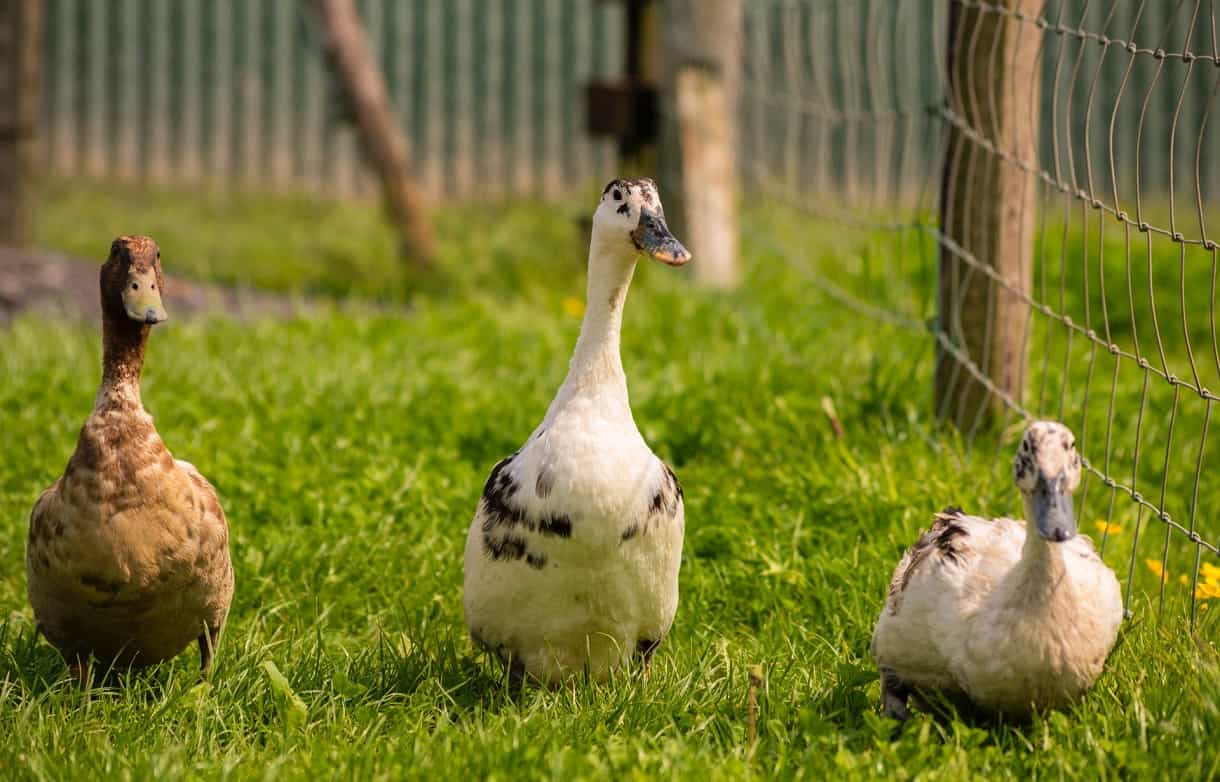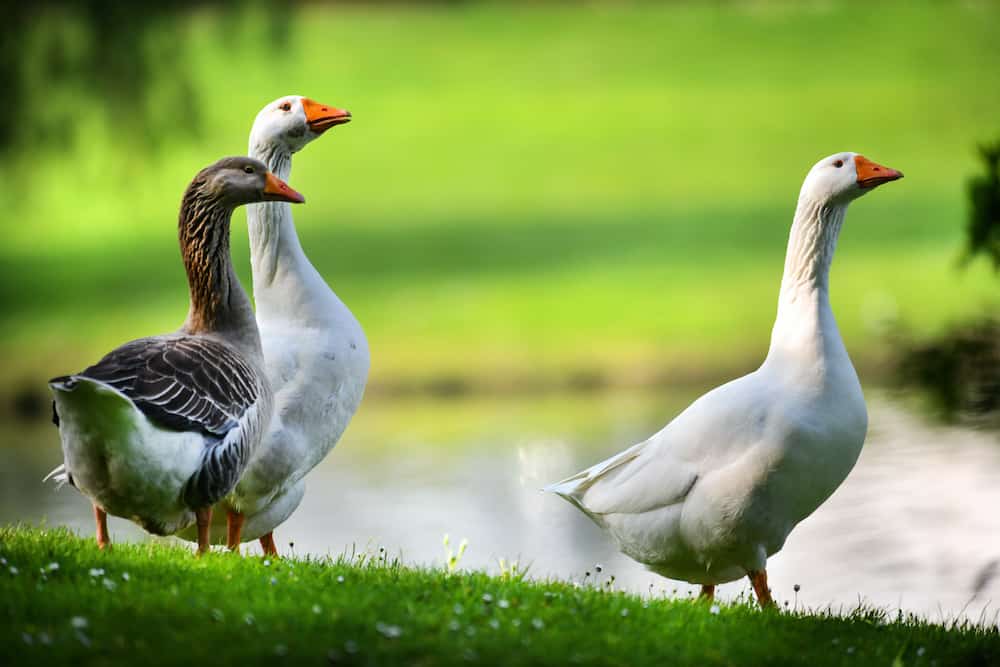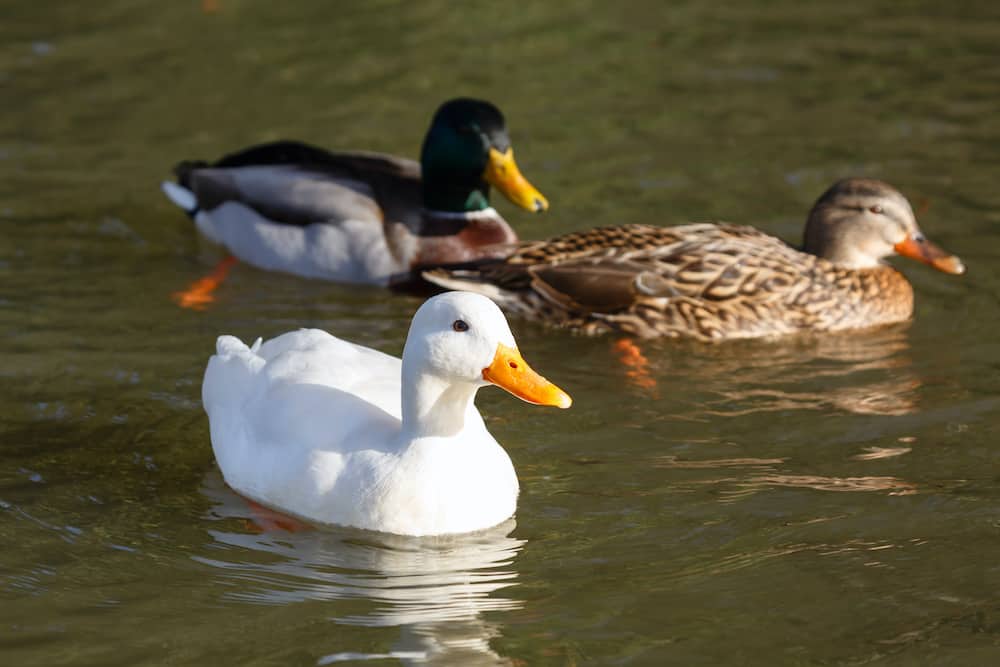There are many domestic duck breeds to consider if you want to raise backyard ducks. Learn which is best whether you want them for meat, eggs, to show, for breeding, or down. Whether you are starting out homesteading or have a small farm, ducks make a good addition.
Many duck breeds are dual-purpose. If you plan to raise them for meat or a pet, you will still have the benefit of eggs. If you want to raise them for eggs, there are duck breeds that lay more than others. Learn about the different types of duck breeds to help you choose the best suited for your purpose. You’ll find raising ducks rewarding.
Duck Breeds
Among the different types of ducks, there are domesticated ducks which have been bred and raised for specific traits. The traits depend on what they are being raised for. Some people want to raise ducks for their down feathers, meat, or egg production. Others may enjoy ducks as family pets.
No matter the reason, these unique domesticated duck breeds will always keep you entertained. There are five major types of domesticated ducks to consider.
Ducks Raised for Meat
Duck meat is popular for its gamey taste and has been hunted around the globe for hundreds of years.
Best Meat Ducks
- Rouen duck
- Muscovy
- Pekin
While it is less common for western cultures to eat duck meat, that’s mostly because it’s difficult to find in grocery stores. In addition, it’s generally more expensive than chicken or turkey meat.
Farmers typically raise a few different duck breeds for the taste of their meat. Some of the more popular duck breeds raised for meat are Jumbo Pekin, Muscovies, Aylesbury, and Rouen. A Rouen duck will weigh 6 – 8 pounds in 3 – 4 months. Alylesbury ducks reach butcher weight in two months. Muscovy ducks will dress at 4 – 6 pounds which is around 3 – 4 months.
Ducks Raised for Eggs
You typically can’t head to your local grocery store and purchase a duck egg, but that doesn’t mean there isn’t a market for them. Duck eggs may not be as famous as chicken eggs in western culture, but they are used in many other types of cuisine.
Best Egg-Laying Ducks
- Khaki Campbell
- Welsh Harlequin
- Indian Runner
- Pekin duck
Many people seek out duck eggs for baking. Selling duck eggs is a way to make money on a farm. When raising ducks for eggs, choose domesticated breeds that lay large duck eggs and produce regularly.
A farmer’s choice of duck breed is the Campbell breeds due to their fast egg-laying production. You can expect them to produce up to 200 eggs yearly. Other duck breeds that are popular for egg production include Runners, Welsh Harlequins, and White Pekins. A Pekin duck is also a good source of meat.
Alternatively, some ducks aren’t considered good layers. One example is the Muscovy duck.
Ducks Raised as Family Pets
While it may be a rare occurrence in the city to see your neighbor raising domestic fowl as pets, out in the country, it is quite prevalent. Raising ducks as pets are common in backyard farms. The most popular type is the popular white-feathered Pekins with orange feet. Other duck breeds for pets are the Cayuga and Indian Runner ducks.
Give them proper shelter outdoors, not inside your home. Ducks are social animals and are not solitary. They can become stressed and upset when isolated or caged. They will thrive with at least one other duck.
Much like raising goats as pets and getting milk, when you raise ducks as pets you can enjoy eggs. They are productive pets.
Raised to Compete in Duck Shows or Breeding
Another breed of domesticated duck are the ones people raise to compete in shows. Duck breeders exist, and they want to show off their lovely ducks if they have particularly good genetics.
Raising commercial ducks for fairs or exhibitions is an excellent way to educate people on the subject. If you’re interested in raising ducks for exhibits, we suggest taking a look at the set standards for your country.
America uses the American Poultry Association’s Standards when breeding. Therefore, be sure you fully understand duck genetics and desirable traits from the organization (4-H or Future Farmers of America in your county) before attempting to raise a fair duck.
Children also raise commercial ducks as 4-H or FFA projects. According to the University of Wisconsin, judges rate them by three categories:
- Market-ready condition
- Rate of gain
- Feed efficiency
Ducks Raised for Down
Duck feathers are different from duck down. Feathers grow to keep the ducks warm. They are what you see as covering the ducks. Down is underneath and also on the belly. It also provides a warm layer.
Duck down is mainly sought after for winter jackets, pillows, and comforters. One of the top-selling down birds is the Eider duck.
Most of the world’s fashion brands prefer eiderdown. It’s known for it’s warmth-to-weight ratio, meaning these feathers are lightweight while providing warmth.
Female eiders will pluck the feathers from their chests in order to keep their eggs warm. In this way, you can raise eider ducks for down humanely though you won’t get as much down as you would when commercial growers raise them.
Generally, it’s better to raise Eiders in cold weather, encouraging them to produce more down. It won’t change the quality of the down, only the quantity.
Domestic Duck Breeds
According to the Department of Animal and Food Sciences, most domesticated ducks originated from the wild mallard. In fact, it is believed that the only known species that has not derived from the mallard is Muscovy ducks.
Depending on what type of product you’re looking for, there’s a wide range of domestic ducks available. Here are the some of the most popular domestic duck breeds:
1. Khaki Campbell
If you want domestic duck breeds due to their egg production qualities, a Khaki Campbell is a good fit. These energetic little birds can lay up to six eggs every week. This makes them a good choice for someone who wants to raise ducks for their egg-laying produce.
For temperament and build, the birds are generally small and can fly. Their demeanor is a bit rowdy, but they are overall friendly. However, they don’t do well in confined spaces; give them protected outdoor space to roam.
2. Eider Ducks
One of the best ducks to raise for down production is an eider duck. Their feathers have a thick layer that helps trap warm heat inside. Worldwide, eiderdown is bought for its powerful insulating effects. If you’re looking to turn a profit, then eider ducks would be your best bet.
3. Welsh Harlequins
Another wonderful breed that is very tame is the Welsh harlequins. These stunning looking birds can produce anywhere from 240 to 330 eggs every year. Plus, they double as a meat production bird, as well.
Welsh Harlequin ducks have good temperament and are highly adaptable to their surroundings. They also work well to actively scout and forage. Additionally, their beautiful speckled feathers are stunning to look at.

Pet Duck Breeds
Have you ever thought of having a pet duck? There are plenty of pet duck breeds that make perfect companions, such as:
1. White Pekin
A White Pekin is what you think of when you imagine a duck. It has white feathers with a distinguishable orange beak and feet. Just think of the “Aflac” duck, and you’ll know what we’re talking about. Pekins are popular because they have two primary purposes. First, they can lay up to 200 eggs per year. Second, they also grow fast and can be used as a meat supply.
They are the most popular breed of duck for meat production and are perfect as pets.
2. Cayuga Ducks
Another favorite is the Cayuga ducks known for their iridescent green and black plumage. They are often a quiet bird with a calm temperament. These ducks are perfect for multi-purpose use, as well. One Cayuga duck can produce up to 150 eggs every year. The breed is scarce, so it would be good to breed them if you have the space to do so.
3. Call Ducks
Call ducks are perfect for suburban areas due to their small stature. They are a tiny bantam breed of ducks that can thrive well with little space. The breed is known for its small stature, pure white feathers, and orange beak and feet. Some say that they look similar to White Pekin ducks. However, they are sometimes half the size of a Pekin.
As for other traits, call ducks are lively, friendly, and enjoy being around people. The downside is that they do love socializing, so your neighbors may not enjoy that as much. Still, call ducks can produce up to 100 small eggs every year, they come in many different colors, too.

Backyard Duck Breeds
Raising ducks are among the best farm animals to raise. However, it’s good to know what breeds are the best for what you want. Choosing a dual-purpose duck breed is best. For backyard duck breeds, you should look for one that possesses certain qualities. For one, they need to be tame and have a quiet demeanor.
Other than that, you’ll want ducks that are friendly and can get along with one another and other animals. A few that fit the bill:
1. Muscovy
One of the highly suggested backyard breeds is the Muscovy duck. The Department of Primary Industries states that domestic Muscovies originated from Europe in the 1560s. They are very friendly birds that do well around other people and animals. Instead of being territorial or aggressive, they bond with everyone around them. They don’t like to be picked up and held.
Aside from that, they don’t tend to make much noise, which is useful if you live in a highly-populated area.
Additionally, they can survive in small areas similar to chickens. However, they do have a habit of roosting, so be sure to provide them with a dry, secured living area with both food and water.
Muscovy ducks can lay between 120 – 180 eggs per year. They may stop laying entirely in the cold winter months as light decreases. If you raise them for meat, you can slaughter a muscovy duck around 3 – 4 months.
2. Mallard
If you don’t live in a suburban area and want to raise a pack of ducks, mallards are the right choice. They don’t do too well in confined areas, so avoid putting them in limited spaces. Plus, the species of ducks are capable of flight and will need to stretch their wings. However, mallards only lay eggs a few times a week.
Compared to other breeds, they do best as decorative pets. They are lively and talk a lot, too, making them a great addition to any empty farmland. Although, you will have to mark them as “domesticated” if you’re living in the US. This is mainly because the Fish and Wildlife Protection may think you’ve stolen them out of the wild.
3. Rouen
A good alternative to Mallards is Rouen. These beautiful ducks have a green-tinted head with a white neck ring. Their bodies are all grey, and some female species feature brown speckles. Rouen is better than Mallards due to its large size and calm nature. Generally, these birds are bigger, which prevents them from taking flight. Additionally, they are known to lay up to five bluish tinted eggs every single week.

Duck Breeds FAQs
1. What are the different kind of ducks?
Generally, we sort the duck breeds into two different categories: domesticated or wild. Wild duck breeds aren’t domesticated or bred by anyone. They just live naturally in the wild. People can still hunt them, but wildlife laws protect some of them.
On the other hand, domesticated ducks have been bred by humans for specific traits. This can be because of the quality of their feathers, meat, or eggs. You can breed ducks for genetics and to show them in competitions. Others breed them for their friendliness and disposition.
2. Can you mix duck breeds?
Yes, you can crossbreed any type of duck with another breed of duck. As long as the two are in the same animal species, they can procreate. Many existing duck breeds have been crossbred from multiple duck breeds. Most breeds of ducks have a common ancestor, though, which is the Mallard. Some were also crossbred with Muscovy ducks.
Overall, if you want to know more about official duck breeds, we suggest looking at breed standards. Each country has its own associations that officially recognize duck breeds.
In America, they rely on the American Poultry Association, and for Britain, they have the Poultry Club of Great Britain.
3. What breed of duck is the friendliest?
Out of all the duck breeds, the friendliest is the White Pekin ducks. They originated from Beijing, China, and have a calm and cheerful temperament. Pekin ducks are multi-purpose birds. You can keep them as pets, bred for meat, and for egg production.
Considering all duck breeds, the Pekin is the best as a pet. Its sunny disposition and curious nature make it both exciting and well-behaved. You will also have the benefit of eggs.
Also, you won’t have to worry about loud squawking in the morning or at night because they mostly communicate with wobbling.
4. What ducks lay the most eggs?
Generally, Pekin or Campbell ducks are known to produce the most eggs each year. However, you will also want to consider other factors. The duck’s living environments, as well as the size of the eggs produced, affect the number of eggs produced each day. Some will go broody and sit in their nests or bedding. Provide opportunities for free ranging as they are foragers. They’ll enjoy insects. What to Feed Ducklings
Other fast egg layers include the Aylesbury or the Runner breeds.
How to Build a Duck House – Helpful Guide for Beginners
Can Ducks Eat Chicken Feed – Duck Feeding 101
Best Domestic Duck Breeds
There are over one hundred different duck breeds in the world. Knowing which to choose for your purpose will be important so you can maximize what is most important to you.
They are great poultry birds for small farms and homesteads. They are a good first choice for raising fowl. Domesticated ducks are slowly becoming the world’s next “chicken.” With over a hundred different crossbreeds in existence, though, it can be hard to find the best domestic duck breeds. Not having a water source holds many people back from raising ducks.
No matter which you choose to raise, we always think that it’s best to go with a breed that suits your neighborhood and your property. If you’re in rural setting and have set up a homestead, adding ducks is a way to have eggs and meat.
